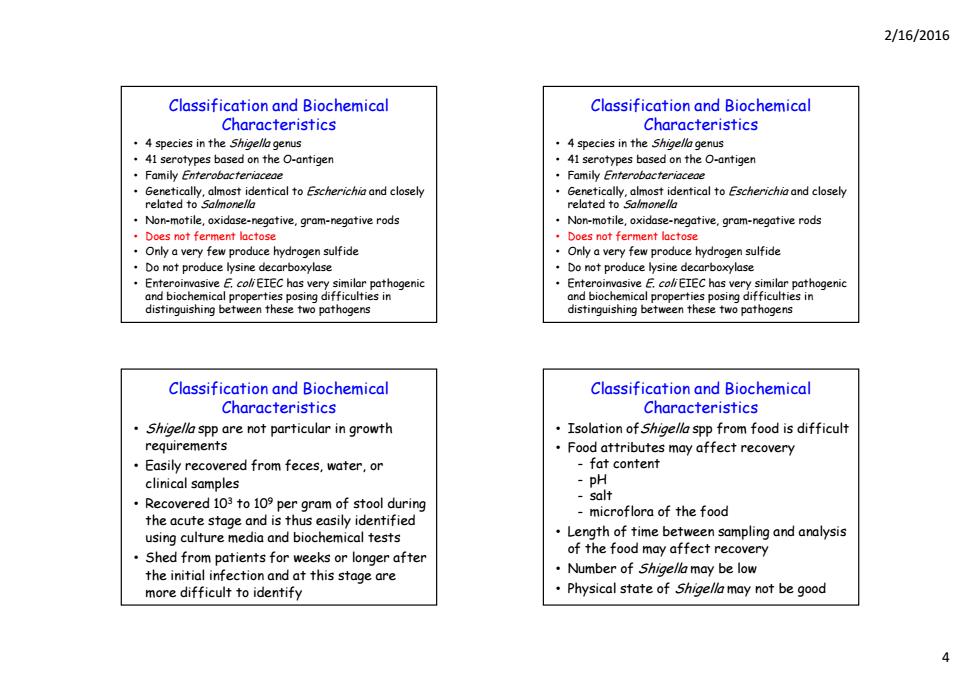正在加载图片...

2/16/2016 Classification and Biochemical Classification and Biochemical Characteristics Characteristics 4 species in the Shigella genus 4 species in the Shigella genus 41 serotypes based on the O-antigen 41 serotypes based on the O-antigen Family Enterobacteriaceae Family Enterobacteriacede Genetically,almost identical to Escherichia and closely Genetically,almost identical to Escherichia and closely related to Salmonella related to Salmonella Non-motile,oxidase-negative,gram-negative rods Non-motile,oxidase-negative,gram-negative rods Does not ferment lactose Does not ferment lactose Only a very few produce hydrogen sulfide Only a very few produce hydrogen sulfide Do not produce lysine decarboxylase Do not produce lysine decarboxylase distinguishing between these two pathogens distinguishing between these two pathogens Classification and Biochemical Classification and Biochemical Characteristics Characteristics Shigella spp are not particular in growth Isolation of Shigella spp from food is difficult requirements Food attributes may affect recovery Easily recovered from feces,water,or fat content clinical samples pH Recovered 103to 109 per gram of stool during salt microflora of the food the acute stage and is thus easily identified using culture media and biochemical tests Length of time between sampling and analysis Shed from patients for weeks or longer after of the food may affect recovery the initial infection and at this stage are Number of Shigella may be low more difficult to identify Physical state of Shigella may not be good2/16/2016 4 Classification and Biochemical Characteristics • 4 species in the Shigella genus • 41 serotypes based on the O-antigen • Family Enterobacteriaceae • Genetically, almost identical to Escherichia and closely related to Salmonella • Non-motile, oxidase-negative, gram-negative rods • Does not ferment lactose • Only a very few produce hydrogen sulfide • Do not produce lysine decarboxylase • Enteroinvasive E. coli EIEC has very similar pathogenic and biochemical properties posing difficulties in distinguishing between these two pathogens Classification and Biochemical Characteristics • 4 species in the Shigella genus • 41 serotypes based on the O-antigen • Family Enterobacteriaceae • Genetically, almost identical to Escherichia and closely related to Salmonella • Non-motile, oxidase-negative, gram-negative rods • Does not ferment lactose • Only a very few produce hydrogen sulfide • Do not produce lysine decarboxylase • Enteroinvasive E. coli EIEC has very similar pathogenic and biochemical properties posing difficulties in distinguishing between these two pathogens Classification and Biochemical Characteristics • Shigella spp are not particular in growth requirements • Easily recovered from feces, water, or clinical samples • Recovered 103 to 109 per gram of stool during the acute stag y e and is thus easily identified using culture media and biochemical tests • Shed from patients for weeks or longer after the initial infection and at this stage are more difficult to identify Classification and Biochemical Characteristics • Isolation ofShigella spp from food is difficult • Food attributes may affect recovery - fat content - pH - salt - microflora of the food • L h f i b li d l i Length of time between sampling and analysis of the food may affect recovery • Number of Shigella may be low • Physical state of Shigella may not be good